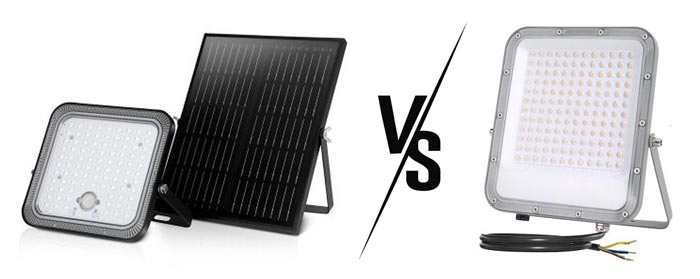In the world of outdoor lighting, LED floodlights have become the go-to solution for illuminating large areas efficiently. Whether it's for security, sports fields, warehouses, parking lots, or residential gardens, LED floodlights offer high luminosity, energy efficiency, and longevity. However, the real question arises when choosing between mains-powered (AC) LED floodlights and solar-powered LED floodlights. Both options serve distinct purposes and come with their own sets of pros and cons.
This article aims to provide a comprehensive comparison between the two types, helping you make a well-informed decision based on your specific needs.

These are wired directly into the electrical grid, drawing power from your local utility provider. They are the traditional form of LED floodlighting and are widely used for both commercial and residential applications.
These operate independently of the grid, using solar panels to charge an internal battery, which then powers the LED light at night. They are commonly used in off-grid areas or where installing electrical wiring is difficult or expensive.
Mains-powered LED floodlights rely on electricity from the grid, which often comes from non-renewable sources. While LED technology is energy-efficient, the sustainability aspect depends on how the electricity is generated.
Solar-powered LED floodlights are inherently more sustainable, using renewable solar energy. They reduce your carbon footprint and contribute to greener living.
Verdict: Solar wins in sustainability.
Mains-powered units often require professional installation due to the need for electrical wiring, trenching, and potentially a permit. This increases initial costs and complexity.
Solar units are generally easier to install, with no wiring required. They can be mounted and set up by almost anyone, making them ideal for DIY projects or remote locations.
Verdict: Solar lights are easier and cheaper to install.
Once installed, mains-powered floodlights incur ongoing electricity costs based on usage and local energy prices.
Solar-powered floodlights run for free after the initial purchase, as they use sunlight to recharge.
Verdict: Solar lights have zero operational costs.
Mains-powered floodlights offer consistent performance, unaffected by weather conditions or seasonal sunlight variations.
Solar-powered units are weather-dependent, meaning reduced performance in cloudy or rainy regions. Battery degradation over time can also affect reliability.
Verdict: Mains-powered is more reliable in all conditions.
Mains-powered LEDs typically have higher lumens and can support high-wattage configurations for stadiums or industrial use.
Solar-powered LEDs are limited by battery capacity and panel efficiency. While newer models are improving, they still generally produce lower brightness compared to mains-powered units.
Verdict: Mains-powered lights are brighter and more powerful.
Mains-powered lights have fewer components that degrade over time (no batteries), making them relatively low-maintenance.
Solar-powered lights require battery replacements every 2–5 years, and solar panels may need occasional cleaning and checks.
Verdict: Mains-powered units are easier to maintain long-term.
Initial cost: Mains-powered lights may be cheaper to purchase but more expensive to install.
Lifetime cost: Solar lights save on electricity and may pay for themselves over time, especially in sun-rich regions.
Verdict: Solar lights are more cost-effective over the long run.
Best for Mains-powered: High-security zones, sports fields, large commercial spaces, or regions with poor sunlight.
Best for Solar-powered: Remote areas, gardens, pathways, temporary installations, and locations where trenching is not feasible.
Comparison Table: Mains vs. Solar LED Floodlights
| Feature | Mains-powered LED Floodlights | Solar-powered LED Floodlights | Verdict |
| Power Source | Electricity (Grid) | Solar Panel + Battery | Depends on setup needs |
| Installation | Requires wiring & professional help | DIY-friendly, no wiring needed | Solar wins for ease |
| Operating Cost | Ongoing electricity costs | Free after purchase | Solar wins |
| Brightness | High (up to 50,000 lumens or more) | Moderate (usually <10,000 lumens) | Mains wins |
| Weather Dependence | Not affected | Performance varies with sunlight | Mains wins |
| Reliability | Very reliable | Battery-dependent, can degrade | Mains wins |
| Maintenance | Low (no batteries) | Medium (battery replacement needed) | Mains wins |
| Eco-friendliness | Depends on energy source | Highly eco-friendly | Solar wins |
| Ideal Use Cases | Stadiums, warehouses, security zones | Gardens, pathways, rural/remote areas | Depends on purpose |
| Initial Cost | Lower product cost, higher setup cost | Higher product cost, lower setup cost | Even |
| Lifetime Cost | Higher due to electricity usage | Lower due to energy savings | Solar wins long-term |
Choosing between a mains-powered and a solar-powered LED floodlight depends entirely on your needs, budget, and location. Here's a quick summary:
Choose mains-powered LED floodlights if you need:
Maximum brightness
Continuous operation regardless of weather
Long-term reliability with minimal maintenance
Lighting for critical infrastructure or high-traffic areas
Choose solar-powered LED floodlights if you want:
Eco-friendly, off-grid solutions
Easy, wire-free installation
Zero electricity cost
Lighting in remote or rural locations
Ultimately, there's no one-size-fits-all answer. In some scenarios, a hybrid solution combining both systems might even be ideal—for example, using mains-powered lights for main roads and solar lights for pathways or decorative lighting.
Whichever you choose, both types of LED floodlights offer significant improvements over older lighting technologies in terms of energy efficiency, lifespan, and functionality. Making the right choice involves weighing short-term investment against long-term benefits, and tailoring the solution to your environment and usage.
Our hours
Mon 11/21 - Wed 11/23: 9 AM - 8 PM
Thu 11/24: closed - Happy Thanksgiving!
Fri 11/25: 8 AM - 10 PM
Sat 11/26 - Sun 11/27: 10 AM - 9 PM
(all hours are Eastern Time)